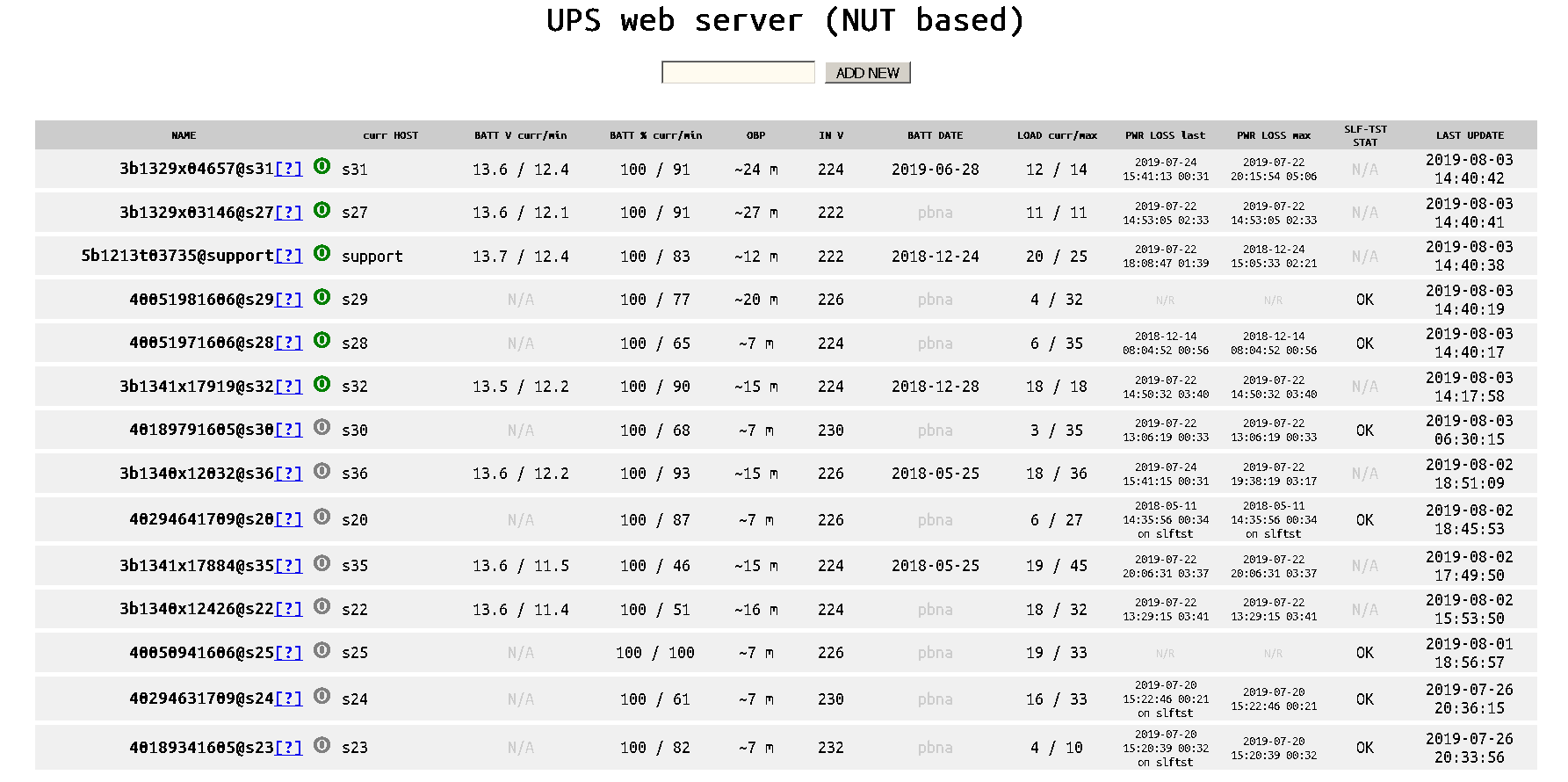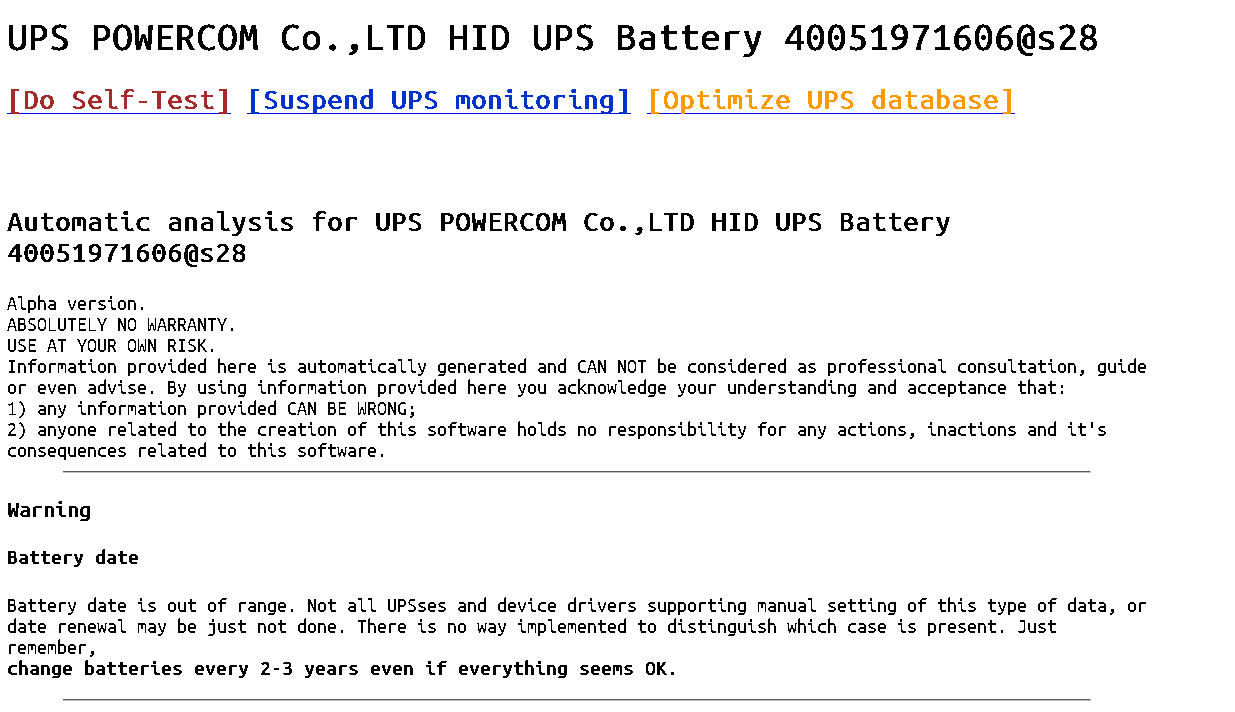Some time ago I built up a system for assessing the viability of office UPSs. The assessment is based on long-term monitoring. Based on the results of using the system, I finished it and learned a lot of interesting things, which I’ll tell you about - welcome to cat.
First partIn general, the idea was correct. From a one-time request to UPS, you can only find out that life is a pain. Some of the parameters are relevant to reality only without 220 V connected, some according to the results of the analysis turn out to be frank delirium, some need to be counted by hand, checking with reality.
Looking ahead, I tried to add these nuances to the system. Well, do not take it with your hands, in fact, we or what automators.
Here, for example, the parameter "
battery percentage ". As a single value, it reports nothing and is usually 100. What is really important: how quickly the battery discharges, how quickly it charges, how many times it has been discharged to critical values. Surprisingly, the UPS does part of this work itself, however, according to very strange formulas; more about that below.
The parameter "
UPS load " is very good and useful. But if you look at it in dynamics, it turns out that sometimes there is nonsense, and sometimes there is interesting information about the connected equipment.
"
Battery voltage. " Almost the Grail, if not for one thing: the absolute majority of the time the battery is on charge, and the parameter displays the voltage of the charge, not the battery. Wait, shouldn't the self-test procedure do this? ..
"
Self-test ". It should, only its results are displayed nowhere. If the self-test fails, the UPS shuts down and screams like a cut, this is the only result available. Plus, not all UPSs report the fact of a self-test.
And “nice try vendor” is the most interesting “
battery runtime ” parameter available. It is designed to predict how long the battery will last under the current load. Also, the internal logic of the behavior of the UPS is tied to it. In fact, he shows pink dreams, especially in a state of full charge.
There were also organizational nuances.
For example, all the UPSs that I got have data on the battery date (as many as two fields). At the same time, I managed to write down these data (after replacing the battery, respectively) only in products from APC, and then dancing with a tambourine. In Powercom, this information can not be shoved in any way, at least under Windows.
The same Powercom distinguished by the same values in the "serial number" field. It is also not subject to recording.
The “
battery runtime ” calculation seems to include values from those periods when 220 V is connected to the UPS, and, accordingly, the battery information is frankly incorrect. In fact, battery runtime can be safely divided by 2, or even by 3. And at the same time, it will still remain a purely synthetic value. In addition, it is based on a “battery load”, which is also noted for oddities: on some instances it does not reset for a long time after a high load, and on others it tends to zero.
Despite such a zoo, you can see that all parameters are still amenable to some algorithmization. This means that you can not just look at the data (and even more so manually view all the available records), but immediately drive the entire array into the analyzer and build recommendations based on them. Which was implemented in the new version of the software.
The UPS Information Page will give warnings and recommendations:
- at least one self-test failure has been registered (if the UPS provides such functionality)
- need to replace battery
- unusual UPS load values
- lack of battery data
- unusual input voltage values
- UPS data usage and maintenance guidelines
(all possible options can be found in ups_additional.php)
A prerequisite for correct analytics, of course, is the maximum possible data collection.
On the main page you can immediately see the maximum and critical values and the correct prediction of the operating time.
And also:
- now the maximum power loss time is correctly considered
- up-to-date information with the UPS is indicated in green, outdated in gray, critical in red and orange
- database optimization procedure was added (it is launched manually, with automatic backup creation)
- Useless information was removed from the main screen and useful information was added :)


Disclaimer:
Of course, this is not entree at all. Almost the entire installation is manual. Tests were not enough, in some places errors pop up. Nevertheless, I take advantage and wish you.
github.com/automatize-it/NUT_UPS_monitoring_webserver_for_WindowsThanks for attention!